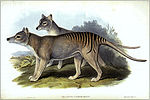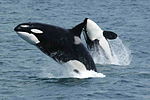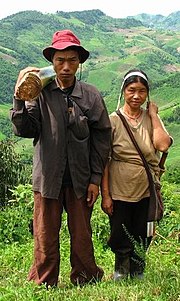A species (pl.: species) is often defined as the largest group of organisms in which any two individuals of the appropriate sexes or mating types can...
103 KB (10,508 words) - 03:26, 20 June 2024
An endangered species is a species that is very likely to become extinct in the near future, either worldwide or in a particular political jurisdiction...
49 KB (5,007 words) - 13:53, 25 June 2024
A vulnerable species is a species which has been categorized by the International Union for Conservation of Nature as being threatened with extinction...
6 KB (758 words) - 07:50, 29 June 2024
An invasive species is an introduced species that harms its new environment. Invasive species adversely affect habitats and bioregions, causing ecological...
127 KB (13,066 words) - 03:16, 24 June 2024
In zoological nomenclature, a type species (species typica) is the species name with which the name of a genus or subgenus is considered to be permanently...
6 KB (796 words) - 07:21, 30 November 2023
introduced species, alien species, exotic species, adventive species, immigrant species, foreign species, non-indigenous species, or non-native species is a...
53 KB (5,848 words) - 01:28, 29 April 2024
On the Origin of Species (or, more completely, On the Origin of Species by Means of Natural Selection, or the Preservation of Favoured Races in the Struggle...
164 KB (18,763 words) - 22:18, 16 June 2024
precise meanings are cryptic species for two or more species hidden under one species name, sibling species for two (or more) species that are each other's closest...
42 KB (3,667 words) - 04:58, 17 May 2024
Speciesism (/ˈspiːʃiːˌzɪzəm, -siːˌzɪz-/) is a term used in philosophy regarding the treatment of individuals of different species. The term has several...
80 KB (9,169 words) - 01:26, 3 June 2024
Extinction (redirect from Species loss)
last member if it loses the capacity to reproduce and recover. Because a species' potential range may be very large, determining this moment is difficult...
105 KB (11,163 words) - 00:20, 3 July 2024
Critically Endangered (redirect from Critically Endangered Species)
An IUCN Red List Critically Endangered (CR or sometimes CE) species is one that has been categorized by the International Union for Conservation of Nature...
7 KB (788 words) - 14:43, 1 May 2024
Version 2014.2 of the IUCN Red List of Threatened Species identified 4574 Critically Endangered species, subspecies and varieties, stocks and subpopulations...
2 KB (184 words) - 17:26, 26 December 2022
of a new species of organism and explain how it differs from species that have been previously described or related species. For a species to be considered...
16 KB (1,821 words) - 14:00, 10 June 2024
IUCN Red List (redirect from Red List of Threatened Species)
International Union for Conservation of Nature (IUCN) Red List of Threatened Species, also known as the IUCN Red List or Red Data Book, founded in 1964, is...
28 KB (2,572 words) - 08:16, 24 June 2024
the IUCN Red List of Threatened Species identified 5220 (2754 animals, 1 fungus, 2464 plant, 1 protist) endangered species, subspecies and varieties, stocks...
2 KB (160 words) - 17:26, 26 December 2022
A keystone species is a species that has a disproportionately large effect on its natural environment relative to its abundance. The concept was introduced...
29 KB (3,186 words) - 18:02, 23 May 2024
A rare species is a group of organisms that are very uncommon, scarce, or infrequently encountered. This designation may be applied to either a plant...
23 KB (907 words) - 18:28, 7 May 2024
A least-concern species is a species that has been categorized by the International Union for Conservation of Nature (IUCN) as evaluated as not being a...
3 KB (346 words) - 18:47, 29 June 2024
Species richness is the number of different species represented in an ecological community, landscape or region. Species richness is simply a count of...
7 KB (823 words) - 18:37, 8 December 2023
number of lists of fictional species: List of fictional extraterrestrials (by media type) Lists of fictional alien species: A, B, C, D, E, F, G, H, I,...
3 KB (183 words) - 12:53, 2 July 2024
Species: The Awakening is a 2007 science fiction action thriller television film and the fourth and final installment of the Species film series. The film...
9 KB (1,074 words) - 23:44, 4 May 2024
Wikispecies (redirect from WikiSpecies)
Foundation. Its aim is to create a comprehensive open content catalogue of all species; the project is directed at scientists, rather than at the general public...
6 KB (590 words) - 19:07, 1 July 2024
Species is a 1995 American science fiction horror film directed by Roger Donaldson and written by Dennis Feldman. It stars Ben Kingsley, Michael Madsen...
41 KB (4,663 words) - 17:47, 28 June 2024
Binomial nomenclature (redirect from Species name)
system"), also called binary nomenclature, is a formal system of naming species of living things by giving each a name composed of two parts, both of which...
57 KB (6,605 words) - 06:00, 5 June 2024
A threatened species is any species (including animals, plants and fungi) which is vulnerable to extinction in the near future. Species that are threatened...
13 KB (1,391 words) - 03:57, 19 May 2024
extinction event. Bamboo species can be divided into two groups: sympodial (clumping) and monopodial (running) species. Sympodial species grow from the soil...
67 KB (319 words) - 15:24, 12 March 2024
Human (redirect from Human species)
modern humans are the most common and widespread species of primate, and the last surviving species of the genus Homo. They are great apes characterized...
262 KB (24,987 words) - 17:30, 3 July 2024
In biogeography, a native species is indigenous to a given region or ecosystem if its presence in that region is the result of only local natural evolution...
12 KB (1,282 words) - 02:19, 16 April 2024
Subspecies (redirect from Sub-species)
biological classification, subspecies (pl.: subspecies) is a rank below species, used for populations that live in different areas and vary in size, shape...
15 KB (1,439 words) - 05:22, 15 May 2024
Species reintroduction is the deliberate release of a species into the wild, from captivity or other areas where the organism is capable of survival....
104 KB (10,079 words) - 12:33, 23 June 2024



















